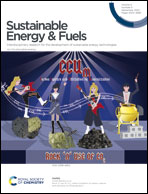Carbon coated 3D Nb2O5 hollow nanospheres with superior performance as an anode for high energy Li-ion capacitors†
Abstract
Li-ion capacitors (LICs) are assembled from a lithium-ion battery (LIB)-type anode and a capacitor-type cathode, but their power density is limited by the battery anode. Looking for high electrochemical performance anode materials is an available approach to improve the properties of LICs. Herein, we report a porous Nb2O5@C hollow nanosphere composite material (3D Nb2O5@C), in which the hollow structure plays a role in buffering the volume expansion during the Li+ insertion and the outer carbon layer enhances the electrical conductivity. In a lithium half-cell, the composite electrode delivers a high capacity of about 134 mA h g−1 at 0.1 A g−1 and exhibits a capacity retention of 72% after 500 cycles. A lithium-ion capacitor fabricated with 3D Nb2O5@C as the anode displays a high energy density of 96.8 W h kg−1 and a high power density of 41 kW kg−1. Moreover, the capacity retention of the LIC is 75% at 2 A g−1 after 3000 cycles. This work shows that 3D Nb2O5@C has the potential to be a superior electrode material in energy storage devices.



 Please wait while we load your content...
Please wait while we load your content...